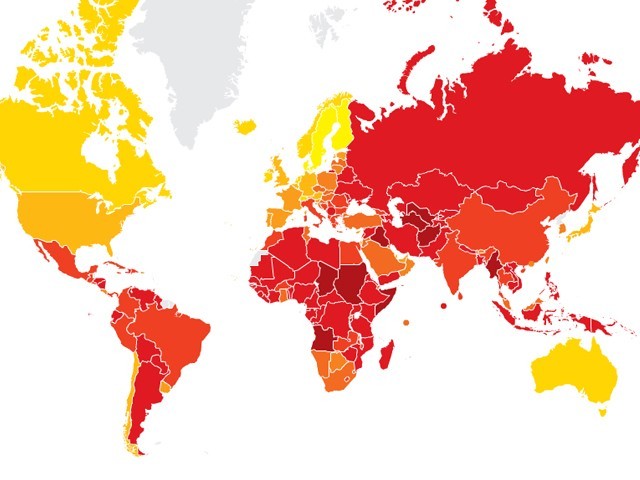
The Corruption Perception Index (lighter colors = less corrupt, darker = more)
Ah, Pakistan. Not only do we consistently top the Failed States Index [see Alex Lobov's take down of the "failed state" term over at Zeitgeist], but this past summer, we also ranked number one in the world in sex-related searches, garnering us the label, “Pornistan” (thanks, Fox News). Jinnah Sahib, (aka, Big Poppa), would be so proud.
On Tuesday, Transparency International released their 2010 Corruption Perceptions Index, which measures the degree to which public sector corruption is perceived to exist in 178 countries around the world. Corruption, according to TI, is defined “as the abuse of entrusted power for private gain,” encompassing practices in both the public and private sectors. The CPI scores countries on a scale from 10 (very clean) to 0 (highly corrupt).
Lo and behold – Pakistan, with a score of 2.3, ranks 143 in the world in the index, dropping 0.2 since 2008. Last year, we were ranked 139 in the CPI, meaning perceptions of corruption are worse than before. (We are 34th most corrupt country, versus 42nd last year).
The interesting part of the index is that it quantifies perceived corruption rather than the tangible occurrence of corrupt practices. According to Transparency International, this is “because corruption – whether frequency or amount – is to a great extent a hidden activity that is difficult to measure.” The organization added in its report, “Measuring scandals, investigations or prosecutions, while offering ‘non-perception’ data, reflect less on the prevalence of corruption in a country and more on other factors, such as freedom of the press or the efficiency of the judicial system.”
Al Jazeera English had a noteworthy discussion today on the reliability of measuring perceptions with TI’s Robin Hodess, former UPI correspondent Sam Vaknin, and David Cole, the managing director of the Atlantic Council. Although Cole affirmed the CPI is a very “well-respected” report with “sound methodology” [the report is an aggregate indicator that brings together data from 13 sources by 10 independent institutions over the past two years], Vaknin contended that perceptions are about psychology, “which is susceptible to manipulation.” For example, he noted, if a government is saying it’s spending an inordinate amount of time fighting corruption, “this may change perceptionsabout corruption” even if the facts on the ground remain the same.
Although the CPI doesn’t measure citizen perceptions of corruption, Hodess noted there is a close correlation between public attitudes (measured by theirGlobal Corruption Barometer) and the index. For the purpose of Pakistan, I went back to the most recent Pew poll released in July [it should be noted that this wasn't some scientific comparison]. According to the poll, 74% of Pakistanis polled say corrupt political leaders “are a very big problem,” compared to 71%last year, 64% in 2007, and 58% in 2002.
This is not to say that these perceptions don’t correlate well to reality, (or that the result of Pakistan’s place on the corruption index was all too surprising), but it does raise some interesting food for thought. For example, what role does the Pakistani media play in changing perceptions about corruption, particularly since electronic news channels have increased considerably in the last few years? Were perceptions in 2002 different because corruption was less rampant or because we didn’t have a liberalized media valiantly raising this issue for debate? In other words, are we more aware about corruption now or has corruption really gotten worse in Pakistan?
As I sifted through news coverage of these rankings, I did also find the reactions and headlines to be pretty interesting. First, The News released an article by Ansar Abbasi entitled, “Pakistan Racing to Become No. 1 Most Corrupt Country.” In the piece published the Sunday before the report was released, Abbasi wrote that sources in the World Bank (WB) and Asian Development Bank (ADB), which contribute to the preparation of the Transparency International report, told The News quite ominously, “You will soon be hearing really bad news about Pakistan.”
A “source” also commented, “It seems the country (Pakistan) is fast racing to become number one on the list of the most corrupt nations.”
This statement – by an anonymous source from one of two different organizations – was subsequently quoted or referenced in the Indian press. Exhibit A: The Times of India headline:
Exhibit B, the Hindustan Times:
And finally, Exhibit C, or the “Kick in the Babymaker,” One India:
Ok, we get it. Pakistan is a corrupt country. This is and has long been a serious issue. We are in the red – literally and figuratively [see TI's nifty map]. But we’renot number one – at least not yet. And more importantly, it’s not a competition!There’s no prize for two countries still ranking pretty high on the index, especially if both rankings worsened from last year! Rather than us both puffing out our chests and measuring our worth relative to the other, maybe we could instead concentrate on actually tackling this issue better (a difficult task if there ever was one).




No comments:
Post a Comment